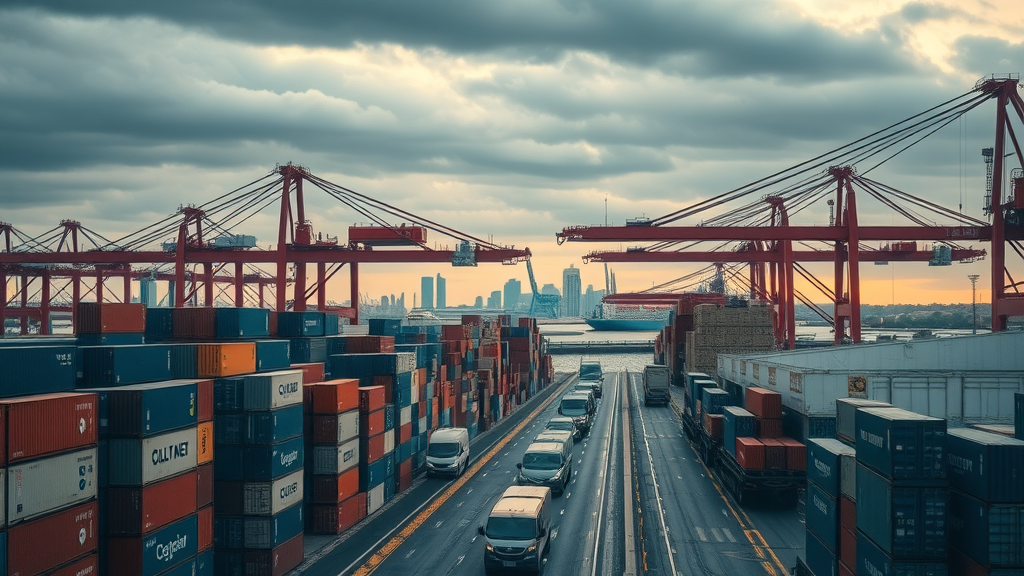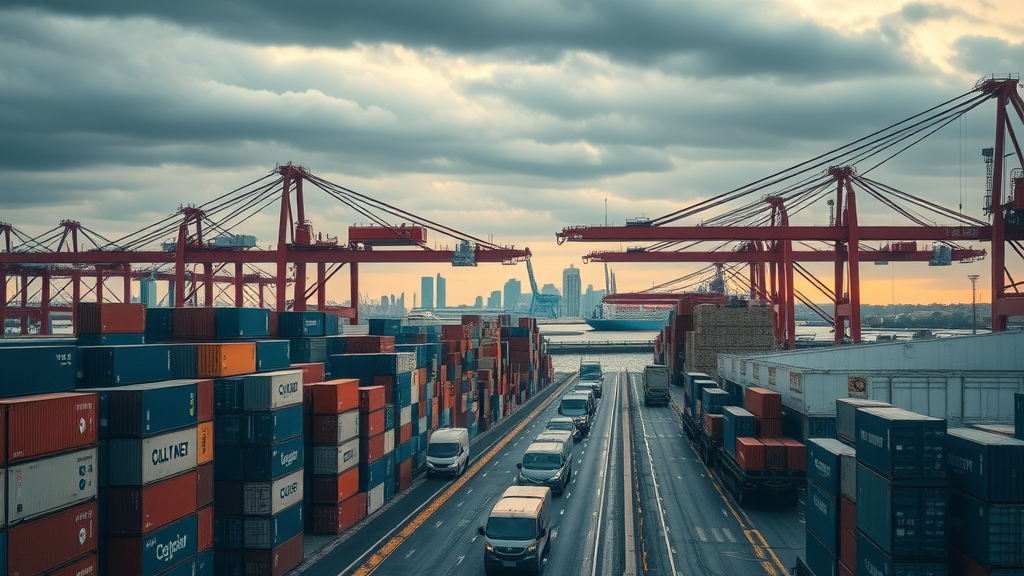Did you know that according to the World Customs Organization, global trade compliance errors cost businesses an estimated $2.5 billion every year? As customs broker responsibilities continue to rise in complexity, being prepared to lead in international trade isn’t just an advantage—it’s a necessity. In this comprehensive guide, you’ll learn everything you need to thrive in the evolving world of customs brokerage.
A Shocking Snapshot: The Increasing Complexity of Customs Broker Responsibilities
In the last decade, customs broker responsibilities have transformed dramatically. Global supply chains are growing more intricate, regulatory changes are more frequent, and digital technology is affecting every stage of customs clearance. Recent updates to customs law and increased security measures demanded by border protection agencies mean that brokers must constantly stay on top of evolving compliance standards. Whether navigating the import and export challenges posed by new trade regulations or adapting to digital customs clearance platforms, customs brokers today are under more pressure than ever before to avoid costly errors and delays.
Customs brokers are not only responsible for guiding shipments safely through complex cross-border processes, but they must also be experts in local and international customs laws and ensure accurate payment of duties and taxes. The stakes are high. Mistakes can result in fines, shipment detentions, or even business loss for importers and exporters. As a result, the role demands more knowledge, adaptability, and leadership skillsets than ever, distinguishing successful customs professionals from those who struggle to keep up in rapidly evolving international trade dynamics.

Why Customs Broker Responsibilities Are More Critical Than Ever in Global Commerce
The global marketplace hinges on fast, reliable movement of goods across borders—and that’s where customs brokers stand as essential gatekeepers. Each item that passes through a customs checkpoint is subject to a web of customs regulations , trade agreements, and shifting security concerns. As goods cross borders, brokers are tasked with interpreting customs and border protection requirements, protecting importers from compliance risks, and supporting global commerce.
Errors in the customs process may slow down global trade for days or weeks, with rippling impacts across the supply chain. That’s why customs brokers, working closely with freight forwarders and customs agents, must remain vigilant as they monitor updates to duties and taxes , tariff codes, and country-specific legislation. Staying current not only prevents penalties, but also builds trust with clients and customs authorities alike.
What You Will Discover About Customs Broker Responsibilities and Leadership in Customs Brokerage
- Gain actionable insights into essential customs broker responsibilities
- Understand key differences between customs brokers and customs agents
- Learn how successful customs brokerage supports international trade
- Find out what sets apart a strong customs broker manager
- Explore trends shaping the future of customs clearance and compliance
Defining Customs Broker Responsibilities: Key Roles in International Trade
Customs brokers are licensed professionals who bridge the gap between businesses and customs authorities. Their core mission is to ensure seamless customs clearance for shipments entering or leaving a country, a critical service for companies relying on cross-border trade. Whether representing importers, exporters, or coordinating with freight forwarders, their daily work demands expertise in trade documentation, regulations, and financial accountability.
From advising on the classification of goods for tariffs to ensuring compliance with constantly changing trade regulations , a skilled customs broker is invaluable. They analyze paperwork, attend to licensing requirements, and monitor legal developments that might impact duties and taxes for goods moving through the supply chain. This pivotal role boosts both operational efficiency and legal certainty in international commerce, facilitating billions of dollars in cross-border transactions every day.

Customs Brokers as Gatekeepers: Ensuring Legal and Efficient Customs Clearance
Customs brokers do more than just push paperwork—they are the front line of defense against costly breakdowns in the international customs clearance process . By thoroughly vetting documents for accuracy and completeness, they safeguard clients from regulatory breaches and shipment holdups. Their familiarity with customs laws , the nuances of specific commodities, and detailed tariff schedules enable them to identify issues early and recommend solutions.
Their work dovetails with customs agents and freight forwarders, ensuring that every declaration aligns with current regulations and that every shipment can clear customs efficiently and legally. With meticulous attention to every stage—from pre-shipment planning to post-entry audits—they function as compliance partners for importers and exporters, actively reducing operational risk and expediting global trade flows.
Customs Broker Responsibilities in Documentation and Regulatory Compliance
A significant portion of customs broker responsibilities revolves around documentation and strict adherence to regulatory compliance . Every inbound or outbound shipment must be properly classified, valued, and documented. Brokers meticulously prepare and verify bills of lading, commercial invoices, import and export licenses, and special certificates demanded by importing nations. Failure to submit the right paperwork or misunderstanding customs regulations can stall goods at the border, sometimes indefinitely.
In today’s environment of heightened security and aggressive trade enforcement, customs brokers are expected to stay up-to-date with the latest customs laws and cross-border mandates. This includes understanding embargoes, quotas, and changing regulatory stances on environmental or health and safety standards. Their vigilance is crucial, creating a reliable path for each consignment, and cultivating strong working relationships with customs officials worldwide.
Duties and Taxes: The Fiscal Side of Customs Broker Responsibilities
Managing duties and taxes is a fundamental responsibility for customs brokers. Each country imposes its own tariff schedules and tax rules based on the value, origin, and type of goods. It falls upon the broker to accurately calculate these costs and ensure their timely payment. Errors or delays in handling fiscal matters can result in steeper fines or additional scrutiny from border protection agencies.
Customs brokers frequently advise clients on strategies to minimize duties within the scope of the law, using free trade agreements and tariff exemptions where appropriate. They also handle the reconciliation of any financial discrepancies identified by customs authorities and maintain meticulous audit trails. This fiscal expertise cements the role of the customs broker as a financial steward and regulatory navigator for global shippers.
"Customs brokers operate at the frontline of international trade, preventing costly errors and streamlining the global flow of goods."
Comparing Customs Brokers, Customs Agents, and Freight Forwarders
When discussing international trade , it’s vital to distinguish between key roles: customs brokers , customs agents , and freight forwarders . While their responsibilities often overlap in the supply chain, each holds a distinct area of focus. Customs brokers are licensed to represent businesses and individuals—primarily guiding them through compliance and paperwork. Customs agents, on the other hand, usually work for the government, ensuring regulations are enforced at ports and borders. Freight forwarders organize the actual movement of goods, coordinating with air, ocean, and land carriers to optimize shipping routes and timing.
Clear lines of responsibility help prevent confusion and ensure each aspect of customs business and logistics is professionally managed. While customs brokers drive compliance and efficient customs clearance, freight forwarders concentrate on moving goods from origin to destination, and customs agents maintain oversight for governments.
| Customs Broker | Customs Agent | Freight Forwarder | |
|---|---|---|---|
| Key Responsibilities | Handles legal compliance and customs clearance | Primarily represents customs authorities | Manages cargo movement and logistics |
| Required Licenses | Licensed by country-specific authority | Usually part of customs office | Varies (often licensed/logistics certified) |
| Client Focus | Works for importers/exporters | Works for customs body | Works for importers/exporters |
Customs Broker vs. Customs Agent: Core Differences
Despite similar titles, customs brokers and customs agents differ in both function and allegiance. Brokers work for companies and individuals, guiding them through tough regulations, preparing documentation, and representing their interests. Customs agents serve in official capacities, typically enforcing the policies and protocols set by government agencies. Their primary job is to inspect, approve, or detain shipments according to country-specific customs laws .
The distinction is crucial—brokers are client advocates, while agents protect governmental interests. This relationship can sometimes be adversarial, but an effective broker values respectful collaboration with customs agents to ensure the smoothest possible clearance process.
The Integral Link Between Customs Brokers and Freight Forwarders
Strong relationships between customs brokers and freight forwarders are essential for international logistics. While freight forwarders manage the actual transport, brokers guarantee compliance. By sharing information on cargo specifications, shipment timelines, and potential compliance challenges , they reduce risk and delays at border crossings.
Collaboration between these roles supports a seamless supply chain. The broker’s expertise in documentation is complemented by the forwarder’s logistical prowess, ensuring goods not only move efficiently but arrive legally and on time.
How Customs Broker Responsibilities Drive Effective Customs Clearance
The ultimate test of a customs broker is their ability to keep goods flowing smoothly through international borders. Their focus on proper paperwork, regulatory vigilance, and timely payment of duties and taxes translates to fewer shipment delays, lower risk of penalty, and improved satisfaction for both clients and customs officials. When they leverage technology and work collaboratively with other supply chain experts, their impact extends throughout the global economy.
Effective customs clearance depends on the broker’s knowledge of the clearance process, ability to interpret fast-shifting trade regulations , and their keen anticipation of issues that may arise with new products, exporters, or regulations. Timely and accurate work prevents backup at busy ports, helps importers and exporters avoid fines, and positions the business as a leader in international trade.
Navigating Documentation: Forms, Manifests, and Regulatory Proof
Customs brokers are trained to handle everything from bills of lading to electronic shipments manifests and country-specific certificates. Every document serves as proof of compliance with local and international laws. A single error—a misplaced digit or an unchecked box—could halt a shipment for days or trigger a customs audit.
Mastery of documentation isn’t just a matter of formality; it’s the gateway to regulatory compliance and risk management. Brokers interact daily with new technologies, including automated import-export declaration systems and regulatory databases, to ensure forms are up-to-date and legally sound. This thorough approach ensures cargo clearance, protects against mistakes, and reassures clients their goods will cross borders without unnecessary holds or expenses.

Managing Duties and Taxes for the United States and Beyond
Navigating duties and taxes presents a formidable challenge for brokers, especially for shipments entering the United States , where complex rules and exemptions frequently shift. Customs brokers must be familiar with U.S. Harmonized Tariff Schedule, trade agreements, and recent legislative amendments to properly advise clients on costs and compliance risks.
This knowledge must extend internationally: every country maintains different duty rates, valuation methods, and documentation. Customs brokers routinely liaise with foreign agents and use their network to keep informed on regulatory changes abroad. This proactive strategy ensures seamless trade and builds client confidence, particularly for businesses looking to expand into new markets.
Leveraging Technology in Customs Brokerage
In today’s rapidly digitizing supply chain, leading customs brokers incorporate cutting-edge technology—such as customs clearance software and automated compliance tools—into their daily workflow. These systems can check documentation for accuracy, flag inconsistencies, and even predict potential regulatory hurdles based on previous shipments.
Digital innovation improves efficiency, reduces the risk of human error, and enhances regulatory compliance. By leveraging these tools, customs brokers can focus more on strategic activities, such as client advisory and process optimization, creating value for both customers and supply chain partners.

Customs Broker Manager: Responsibilities and Skills for Leadership
A customs broker manager plays a pivotal role overseeing the entire customs clearance process, ensuring every shipment complies with global regulations and contractual SLAs. This leadership position requires not only technical knowledge, but also sophisticated team management and problem-solving skills. A manager is both ambassador and strategist—balancing client expectations with the realities of cross-border trade.
Their day-to-day responsibilities range from setting compliance policies and monitoring industry changes, to coaching junior brokers, liaising with freight forwarders and customs agents, and troubleshooting complex shipments. A strong manager can grow a customs business, protect clients’ interests, and foster a culture of continuous learning and adaptability—setting the standard for excellence within the organization.
Key Functions and Teamwork in a Customs Brokerage Firm
- Overseeing customs clearance workflows
- Ensuring compliance with international trade laws
- Training and mentoring junior customs brokers
- Coordinating with freight forwarders and customs agents
Leadership in customs brokerage goes beyond technical knowledge. True leaders understand team dynamics, foster open communication, and encourage anticipate-and-adapt thinking throughout the firm. By emphasizing teamwork and cross-functional collaboration, managers fortify the organization’s reputation with customs authorities and clients alike.
"Leadership in customs brokerage means not only understanding regulatory frameworks, but also shaping teams that keep global trade secure and efficient."
Case Study: Real-World Scenarios Highlighting Customs Broker Responsibilities
To truly understand the importance of customs broker responsibilities, consider real-life examples. These scenarios highlight the range of challenges customs brokers encounter and illustrate the value of expertise and proactive problem solving in ensuring seamless trade.
Let’s explore two scenarios: a technology import into the United States and the most common compliance challenges that brokers can face on any given day.
Successful Customs Clearance: Importing Technology Goods into the United States
Recently, an American electronics importer faced potential shipment delays due to shifting customs regulations and increased documentation scrutiny. The customs broker responsible for the clearance process worked swiftly to review each piece of import documentation, confirm compliance with U.S. requirements, and communicate effectively between the shipper and U.S. Customs and Border Protection.
Thanks to the broker’s expertise, the shipment cleared U.S. customs without any penalties or delays, saving the importer thousands of dollars in potential fees and lost sales. This kind of operational excellence separates top-tier customs brokers from the rest, especially in high-stakes industries like technology.

Avoiding Pitfalls: Common Compliance Challenges for Customs Brokers
Mistakes in document submission, unfamiliarity with newly updated trade regulations , or misclassification of goods can trigger penalties, delays, or even shipment confiscation. Customs brokers regularly face these pitfalls, especially when working with new clients or in emerging markets with unstable legal environments.
Strong brokers keep pace with regulatory updates via government websites and industry bulletins, build robust relationships with customs officials, and invest in ongoing team training. By developing a resilient, detail-focused clearance process , they minimize client risk and deliver consistent value.
Emerging Trends and the Future of Customs Broker Responsibilities
The world of customs brokerage is changing fast. Technology, sustainability, and shifting trade policies all shape how brokers operate. With every regulatory change and innovation, their responsibilities grow more complex—but also more rewarding for those willing to adapt.
Digital documentation, increasing expectations for transparency, and a renewed focus on environmental stewardship are changing how brokers interact with clients, government bodies, and global supply chain partners. In this climate, forward-thinking brokers will be best positioned to lead.
Sustainability and Digitalization in International Trade
Green initiatives are having an outsized impact on trade. Customs brokers must now consider emissions reporting, packaging standards, and eco-tariffs as part of their daily compliance activities. Meanwhile, the drive toward fully digital customs offices means brokers must adopt new software and automation—further emphasizing the role of technology in risk management and regulatory compliance.
These trends require not just knowledge, but also agility and foresight—get ahead of regulatory changes and help clients adopt more sustainable, future-proof trade practices.
Regulatory Changes Impacting Duties and Taxes Worldwide
Governments worldwide are evolving the tax and tariff landscape to reflect new economic priorities, such as digital goods, emerging industries, and shifting alliances. Customs brokers must constantly update their fiscal knowledge, anticipate the impact of new trade agreements, and communicate their effects clearly to clients.
In practice, this creates both challenges and opportunities—brokers who remain informed and quickly adapt their processes can turn regulatory turbulence into a competitive strength, offering peace of mind and expert advisory to both new and existing clients.

Which of the following is the responsibility of a customs broker?
A customs broker is responsible for ensuring that shipments comply with all customs laws, preparing and submitting the required documentation for customs clearance, calculating and organizing payment for duties and taxes, and advising clients on regulations affecting international trade. Additionally, customs brokers act as intermediaries between importers/exporters and customs authorities, handling licensing, classifying goods, and facilitating communication with border protection agencies.
They also keep abreast of changing legislation and utilize technology to streamline the customs clearance process , ensuring efficiency and minimizing errors. This comprehensive skill set is what makes customs brokers essential guardians of legal and effective global trade.
What are the duties of a customs agent?
A customs agent is typically an official government representative responsible for enforcing customs laws at border points, inspecting shipments, and verifying that goods comply with import and export regulations. Customs agents review documentation, assess the legality of imports and exports, collect duties and taxes, and investigate suspected regulatory violations.
Their core responsibilities prioritize national security and regulatory enforcement, ensuring that only approved goods cross borders lawfully. Customs agents frequently collaborate with customs brokers to clarify requirements and resolve issues as part of their daily duties.
What is the difference between a customs broker and an agent?
The key distinction lies in their roles and allegiances: customs brokers are licensed professionals representing companies and individuals, guiding client shipments through complex regulations and customs clearance . Customs agents work on behalf of the government, monitoring compliance, performing inspections, and enforcing official policies and procedures.
While a broker advocates for clients, an agent upholds regulatory standards and national interests. Both are critical to the effective functioning of international trade, but their priorities and responsibilities differ markedly.
What is a customs broker manager job description?
A customs broker manager oversees a team of brokers, ensuring each shipment meets legal requirements and every documentation process is followed precisely. They manage workflows, ensure ongoing training, resolve escalated issues, and serve as the chief liaison with both clients and government officials. Their role integrates leadership, strategic planning, and regulatory expertise—coordinating all elements of the customs business for smooth operations and maximum compliance.
Frequently Asked Questions About Customs Broker Responsibilities
- How do I become a customs broker? Becoming a customs broker generally requires passing a licensing exam administered by a government agency—such as U.S. Customs and Border Protection. Candidates must often meet eligibility and experience requirements, as well as demonstrate a thorough understanding of customs laws, international trade, and tariff classification.
- What are the most critical skills for a customs broker? Successful customs brokers blend regulatory knowledge, attention to detail, strong organizational skills, and effective communication. Problem-solving and adaptability are also crucial, as the regulatory landscape and supply chain conditions evolve rapidly in global trade.
- How do customs brokers collaborate with freight forwarders? Customs brokers and freight forwarders coordinate closely, sharing shipment data and documentation to ensure smooth customs clearance and timely delivery of goods. This partnership is essential for efficient logistics and compliance with all cross-border requirements.
- What software is used in customs brokerage? Leading customs brokers use software tools for electronic document preparation, tariff classification, compliance monitoring, and shipment tracking. Examples include customs management solutions, trade compliance databases, and government electronic filing platforms.
- Can customs brokers represent both importers and exporters? Yes, customs brokers are authorized to act on behalf of both importers and exporters, provided they hold a valid broker license and comply with all regulatory requirements for each transaction. This flexibility allows brokers to serve a diverse range of clients in global trade.
Key Takeaways for Aspiring Leaders in Customs Brokerage
- Customs broker responsibilities are central to legal, efficient international trade
- Active leadership and compliance skills are essential for customs broker managers
- Continuous adaptation is vital as global trade regulations and technologies evolve
Ready to Channel Your Expertise? Connect With Us About Customs Broker Responsibilities
Have insights to share on global trade? Let's talk— call us at 203-271-7991 to explore contributing an article about customs broker responsibilities and leadership in international trade!
Explore the details and challenges that customs brokers encounter daily—watch our exclusive insider’s video for practical insights and inspiration.
Stay ahead of the curve in customs brokerage! Discover how digital innovation is reshaping compliance, documentation, and client services in this informative video.
To deepen your understanding of customs broker responsibilities, consider exploring the following resources:
-
“What is the Role of a Customs Broker?” ( df-alliance.com )
-
“Customs Broker: Logistics Guide” ( fulfill.com )
These articles provide comprehensive insights into the duties and significance of customs brokers in international trade.
 Add Row
Add Row  Add
Add 




Write A Comment